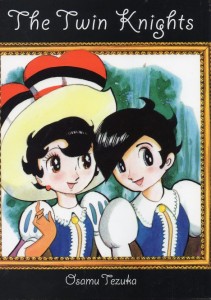Manga Review: The Twin Knights by Osamu Tezuka
This is a sequel to the classic Osamu Tezuka work Princess Knight (“Ribon no Kishi” or “The Ribbon Knight” in Japanese), about Sapphire, a princess raised as a boy due to strange circumstances. Queen Sapphire is now married and gives birth to twins, Prince Daisy and Princess Violetta. There’s a question of succession, as the inheritance rules were changed to allow women to ascend the throne of Silverland, but don’t account for twins.
The equivalent of a coin flip makes Prince Daisy the heir apparent, which enrages the Duke and Duchess of Dahlia. They kidnap the prince and have him abandoned in the Forest of Slobb. To calm the people while the search for the missing prince is ongoing, Queen Sapphire and her husband regretfully decide to have Violetta disguised as her brother on alternate days.
Years pass, and when Violetta is in her teens, things reach a crisis point. She must leave the castle to seek out her brother, who, yes, is still alive. Many perils await, and not all who begin this fairy tale will be alive at the end of it.
Osamu Tezuka innovated in many areas of Japanese comics, and Princess Knight was one of the first shoujo manga (girls’ comics) in Japan; certainly it’s the first one anyone still remembers. This sequel was also written in the 1950s It shares the same simple but dynamic art style and attitudes towards gender issues that were progressive for the time it was written but seem outdated today.
There’s a lot of exciting action, some comedy, and a bit of confusion involving mistaken identities. Princess Violetta ends up impersonating Prince Daisy, impersonating himself! Even though Queen Sapphire is much more ladylike now, she hasn’t forgotten her sword skills. In the fairy tale tradition, there are several deaths, with the evil tending to die gruesomely (but tastefully–this isn’t a gorefest.)
An important supporting character is Emerald, Queen of the Gypsies. Although she and her people are depicted sympathetically (and Emerald is heroic when her temper doesn’t get the better of her), it’s still pretty stereotypical. Parents may want to talk to their children about the real-life Roma and the prejudice against them.
I’d especially recommend this volume (and the series it’s a sequel to) to fans of the Disney princesses, as Tezuka took a lot of his early inspiration from the Walt Disney style.


Hello! Dropping in from The Inspired Blogging Group. I love the span of interests you have with your reviews! Makes me want to expand my horizons! Thank you!
I’ve been trying harder in the last couple of years to stretch my reading envelope. .I’ve learned many new and exciting things!
Stopped by to read another great review! Nicely done!
Thank you!
I remember reading Princess Knight years ago. I’ll have to check this sequel out. Thanks for the review!
It’s nice to finally get some of the Osamu Tezuka classics out in English.